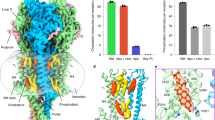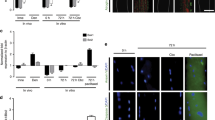Abstract
THE inhibitory effect of curare on the transmission of nerve impulses across myoneural junctions is generally attributed to its binding with the specific acetylcholine receptors in the motor end-plate membranes in competition with the acetylcholine, thereby preventing the ester from exerting its depolarizing action. Since the work of Claude Bernard, it has been known that curare acts specifically on the motor end-plates without any effect on axonal conduction. The failure of externally applied acetylcholine to affect conduction of nerve fibres was explained by Nachmansohn1 as being due to permeability barriers surrounding the axon which are impermeable to lipid-insoluble compounds, such as methylated quaternary nitrogen derivatives, and cannot reach, therefore, the interior of the axon. These permeability barriers also explain the absence of any action of curare on axonal conduction: if monoquaternary ammonium salts are unable to penetrate these barriers, it is certainly to be expected that diquaternary salts will not enter. This does not indicate that the acetylcholine receptor upon which curare is supposed to act at the myoneural junction is not present and functional in the axon, only that it cannot be reached. If this viewpoint is correct, then diquaternary compounds which have two cationic nitrogens at the proper distance but are in addition soluble in lipid, such as stilbamidine, should have curare-like action. Block of conduction by stilbamidine was obtained by Bergmann, Wilson and Nachmansohn2 on the axon, and by Schoffeniels and Nachmansohn3 on the conducting membrane of the electroplax of Electrophorus electricus.
This is a preview of subscription content, access via your institution
Access options
Subscribe to this journal
Receive 51 print issues and online access
$199.00 per year
only $3.90 per issue
Buy this article
- Purchase on Springer Link
- Instant access to full article PDF
Prices may be subject to local taxes which are calculated during checkout
Similar content being viewed by others
References
Nachmansohn, D., “Chemical and Molecular Basis of Nerve Activity” (Acad. Press, New York, 1959).
Bergmann, F., Wilson, I. B., and Nachmansohn, D., Biochim. Biophys. Acta, 6, 217 (1950).
Schoffeniels, E., and Nachmansohn, D., Biochim. Biophys. Acta, 6, 1 (1957).
Stämpfli, R., J. Physiol. (Paris), 48, 710 (1956).
Dettbarn, W. D., Biochim. Biophys. Acta (in the press).
Dettbarn, W. D., in Proc. Symp. Origin of Bioelectrogenesis, Rio de Janeiro (Elsevier Pub. Co., Amsterdam, 1959).
Author information
Authors and Affiliations
Rights and permissions
About this article
Cite this article
DETTBARN, W. Effect of Curare on Conduction in Myelinated, Isolated Nerve Fibres of the Frog. Nature 186, 891–892 (1960). https://doi.org/10.1038/186891a0
Issue Date:
DOI: https://doi.org/10.1038/186891a0
This article is cited by
-
Collagenase and hyaluronidase pretreatment induces sensitivity to d-tubocurarine in frog sciatic nerve
Naturwissenschaften (1981)
Comments
By submitting a comment you agree to abide by our Terms and Community Guidelines. If you find something abusive or that does not comply with our terms or guidelines please flag it as inappropriate.



